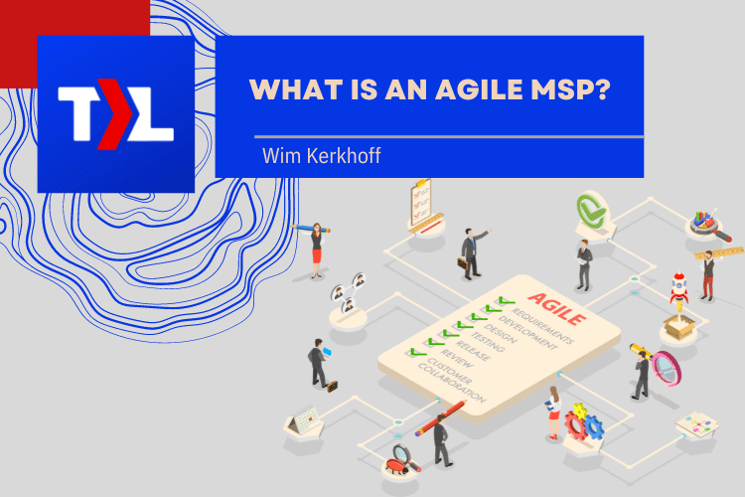In the world of managed service providers (MSPs), agility is the key to success. But what exactly does it mean to be an Agile MSP? In this article, we'll delve into the concept, popular frameworks, the benefits of adopting an Agile approach, and the factors to consider when embracing agility in the MSP realm. So, let's jump right in and uncover the secrets of Agile MSPs.
What is Agile MSP?
Traditional approaches no longer suffice in today's fast-paced and dynamic business environment. Enter the Agile MSP – a new breed of service provider that combines the best of Agile methodologies with the expertise of MSPs.
Rather than following rigid plans, Agile MSPs adapt to evolving client needs and leverage iterative processes to deliver value consistently. This flexibility and customer-centric approach set them apart from traditional MSPs. This blog post will explore what it means to be an Agile MSP and how this approach revolutionizes service delivery.
What Makes Agile MSP Different from Non-Agile MSP?
Agile MSPs (Managed Service Providers) differentiate themselves from non-agile MSPs by adopting agile methodologies and principles in their service delivery. Here are some factors that make Agile MSPs different and potentially better:
1. Flexibility and Adaptability
Agile MSPs are more flexible and adaptable to changing customer needs and market conditions. By working in iterative cycles and continuously gathering feedback, Agile MSPs can adjust their services and solutions to align with evolving business needs.
2. Customer-Centric Approach
Agile MSPs prioritize customer satisfaction and collaboration. They involve customers throughout the service delivery process, seeking feedback and incorporating it into their work. This customer-centric approach helps Agile MSPs better understand customer expectations, deliver value early and frequently, and build strong customer relationships.
3. Faster Time to Value
Agile methodologies like Scrum and Kanban focus on delivering value in short iterations or work increments. Agile MSPs break down their projects into smaller, manageable units and deliver incremental value to customers. This approach enables them to provide tangible results and benefits to customers more quickly, reducing time to value compared to traditional, non-agile MSPs.
4. Improved Communication and Transparency
Agile MSPs emphasize frequent communication and collaboration within their teams and with customers. They often use visual management tools like Kanban boards or project dashboards to enhance transparency and inform all stakeholders about project status, progress, and potential issues. This transparency helps manage customer expectations, resolve conflicts, and foster trust between the MSP and the customer.
5. Continuous Improvement
Agile MSPs embrace a culture of continuous improvement. They regularly reflect on their processes, outcomes, and customer feedback to identify areas for improvement and implement changes incrementally. By continuously refining their service delivery practices, Agile MSPs can enhance efficiency, productivity, and customer satisfaction over time.
6. Emphasis on Team Empowerment
Agile methodologies promote self-organizing, cross-functional teams that are empowered to make decisions and take ownership of their work. Agile MSPs foster a collaborative and supportive environment where team members have the autonomy to plan and execute their tasks. This empowerment enhances team morale, engagement, and accountability, improving service quality and customer outcomes.
While Agile MSPs offer several advantages, it's worth noting that the suitability and effectiveness of agile practices depend on the specific context, customer requirements, and organizational culture.
Two Popular MSP Framework
When adopting an Agile approach in the MSP realm, having the right frameworks in place is crucial. These frameworks provide structure, guidance, and a proven methodology to help MSPs navigate the complexities of agile service delivery. This section will explore two popular Agile MSP frameworks: the Agile MSP Manifesto and Scrum for MSPs.
1. Scrum for Managed Services
Scrum is an iterative and incremental agile framework that focuses on delivering value in short iterations. Some organizations adopt the Scrum framework to manage their managed services projects by breaking them down into smaller, manageable units and applying the core principles of Scrum, such as the use of cross-functional teams, time-boxed iterations (sprints), and continuous feedback.
2. Kanban for Managed Services
Kanban is a visual management method that emphasizes continuous flow and limiting work in progress (WIP). Some managed service providers adopt the Kanban approach to track and manage the flow of service requests, tasks, and incidents. It provides visibility into work status, identifies bottlenecks, and encourages the team to optimize their workflow continuously.
If you wish to learn more about the two frameworks and deep-dive between the similarities and differences, you can read them here.
Factors to Consider on Adoption
Embracing agility in the MSP realm requires careful consideration and preparation. Before MSPs embark on their Agile journey, several key factors must be evaluated. From assessing organizational readiness to understanding client engagement and project management practices, these considerations play a vital role in successful Agile MSP adoption.
a. Organizational Readiness
Before embracing Agile methodologies, MSPs need to assess their organizational readiness. This involves evaluating their culture, infrastructure, and processes to determine if they are conducive to an Agile approach. It may require cultural shifts, training, and establishing the right tools and frameworks.
b. Client Engagement and Expectations
Adopting an Agile MSP approach requires client buy-in and active engagement. MSPs must educate their clients about Agile principles, set expectations regarding collaboration, and emphasize the benefits of iterative development. Building strong client relationships and trust is crucial in the Agile MSP model.
c. Agile Project Management and Metrics
MSPs must incorporate Agile project management practices and metrics to track progress effectively. This involves defining project goals, establishing measurable objectives, and implementing tools and processes to monitor and communicate progress transparently.
Role of Kanban in Agile MSP
Besides the Agile MSP concepts mentioned above, Kanban is another valuable tool in the Agile MSP toolkit. Kanban is a visual project management approach that helps teams visualize their workflow, limit work in progress, and optimize efficiency. In the context of Agile MSP, Kanban is a means to achieve flow, transparency, and continuous improvement. Kanban provides several benefits to Agile MSPs, including:
a. Workflow Visualization
Kanban boards allow MSPs to visualize their tasks and track KPIs, providing a clear overview of the work in progress. This visual representation fosters transparency, enabling teams to identify bottlenecks, balance workloads, and make data-driven decisions.
b. Limiting Work in Progress (WIP)
By setting work-in-progress limits, Kanban helps prevent overload and ensures a smooth flow of tasks. Agile MSPs can focus on completing existing work before taking on new tasks, reducing multitasking and increasing productivity.
c. Continuous Improvement
Kanban promotes a culture of continuous improvement by encouraging teams to analyze their processes, identify areas for enhancement, and implement changes incrementally. This iterative approach fosters a learning mindset and drives efficiencies in the MSP workflow.
___
In conclusion, Agile MSP (Managed Service Provider) represents a paradigm shift in IT project management and service delivery. By combining Agile methodology principles with MSPs' expertise, organizations can benefit from increased flexibility, faster time to market, and improved customer satisfaction. If you wish to explore the many advantages of adopting an Agile MSP, we at TopLeft offer comprehensive training and consulting services to make it less overwhelming for you and your team.
After knowing what is an An Agile MSP, take another dip at what an Agile Project Management is as Steve Psaradellis discussed how making your work visible, and limiting your Work-in-Progess (WIP) contribute to agile project management.
Agile Project Management


